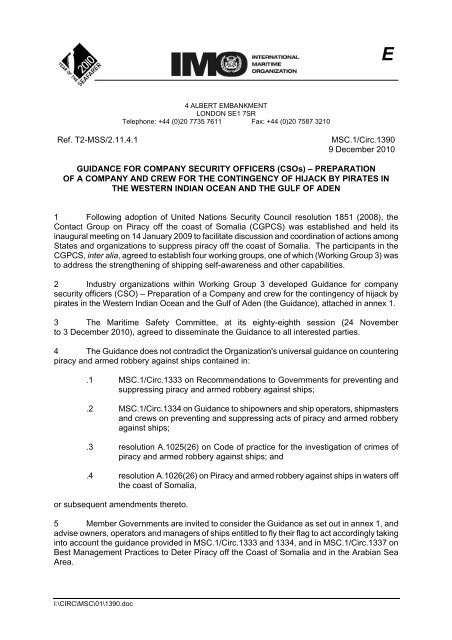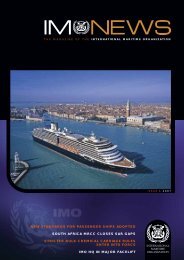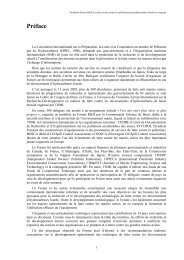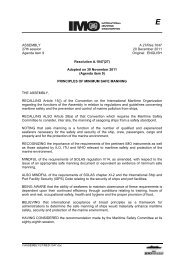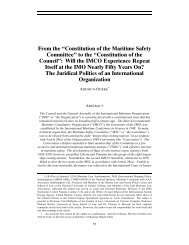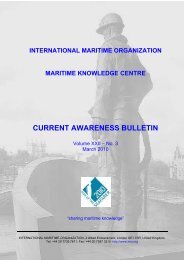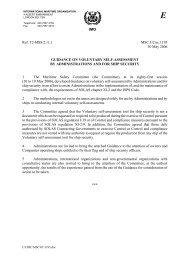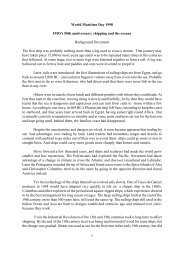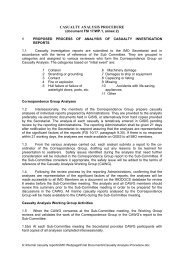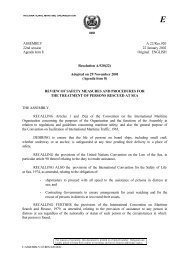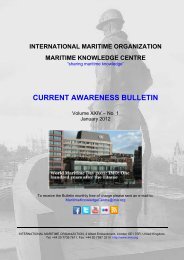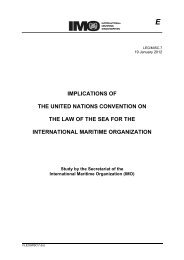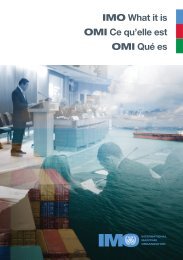Ref. T2-MSS/2.11.4.1 MSC.1/Circ.1390 9 December 2010 ... - IMO
Ref. T2-MSS/2.11.4.1 MSC.1/Circ.1390 9 December 2010 ... - IMO
Ref. T2-MSS/2.11.4.1 MSC.1/Circ.1390 9 December 2010 ... - IMO
You also want an ePaper? Increase the reach of your titles
YUMPU automatically turns print PDFs into web optimized ePapers that Google loves.
E<br />
4 ALBERT EMBANKMENT<br />
LONDON SE1 7SR<br />
Telephone: +44 (0)20 7735 7611 Fax: +44 (0)20 7587 3210<br />
<strong>Ref</strong>. <strong>T2</strong>-<strong>MSS</strong>/<strong>2.11.4.1</strong><br />
<strong>MSC.1</strong>/<strong>Circ.1390</strong><br />
9 <strong>December</strong> <strong>2010</strong><br />
GUIDANCE FOR COMPANY SECURITY OFFICERS (CSOs) – PREPARATION<br />
OF A COMPANY AND CREW FOR THE CONTINGENCY OF HIJACK BY PIRATES IN<br />
THE WESTERN INDIAN OCEAN AND THE GULF OF ADEN<br />
1 Following adoption of United Nations Security Council resolution 1851 (2008), the<br />
Contact Group on Piracy off the coast of Somalia (CGPCS) was established and held its<br />
inaugural meeting on 14 January 2009 to facilitate discussion and coordination of actions among<br />
States and organizations to suppress piracy off the coast of Somalia. The participants in the<br />
CGPCS, inter alia, agreed to establish four working groups, one of which (Working Group 3) was<br />
to address the strengthening of shipping self-awareness and other capabilities.<br />
2 Industry organizations within Working Group 3 developed Guidance for company<br />
security officers (CSO) – Preparation of a Company and crew for the contingency of hijack by<br />
pirates in the Western Indian Ocean and the Gulf of Aden (the Guidance), attached in annex 1.<br />
3 The Maritime Safety Committee, at its eighty-eighth session (24 November<br />
to 3 <strong>December</strong> <strong>2010</strong>), agreed to disseminate the Guidance to all interested parties.<br />
4 The Guidance does not contradict the Organization's universal guidance on countering<br />
piracy and armed robbery against ships contained in:<br />
.1 <strong>MSC.1</strong>/Circ.1333 on Recommendations to Governments for preventing and<br />
suppressing piracy and armed robbery against ships;<br />
.2 <strong>MSC.1</strong>/Circ.1334 on Guidance to shipowners and ship operators, shipmasters<br />
and crews on preventing and suppressing acts of piracy and armed robbery<br />
against ships;<br />
.3 resolution A.1025(26) on Code of practice for the investigation of crimes of<br />
piracy and armed robbery against ships; and<br />
.4 resolution A.1026(26) on Piracy and armed robbery against ships in waters off<br />
the coast of Somalia,<br />
or subsequent amendments thereto.<br />
5 Member Governments are invited to consider the Guidance as set out in annex 1, and<br />
advise owners, operators and managers of ships entitled to fly their flag to act accordingly taking<br />
into account the guidance provided in <strong>MSC.1</strong>/Circ.1333 and 1334, and in <strong>MSC.1</strong>/Circ.1337 on<br />
Best Management Practices to Deter Piracy off the Coast of Somalia and in the Arabian Sea<br />
Area.<br />
I:\CIRC\MSC\01\1390.doc
<strong>MSC.1</strong>/<strong>Circ.1390</strong><br />
Page 2<br />
6 Intergovernmental and non-governmental organizations with consultative status are<br />
also invited to consider the Guidance as set out in annex 1 and to advise their membership to<br />
act accordingly, taking into account the guidance provided in <strong>MSC.1</strong>/Circ.1333, 1334 and 1337.<br />
7 Member Governments and intergovernmental and non-governmental organizations with<br />
consultative status are invited to consider bringing the results of the experience gained from<br />
using the Guidance, as set out in annex 1, to the attention of the Committee.<br />
***<br />
I:\CIRC\MSC\01\1390.doc
<strong>MSC.1</strong>/<strong>Circ.1390</strong><br />
Annex, page 1<br />
ANNEX<br />
GUIDANCE FOR COMPANY SECURITY OFFICERS (CSO) – PREPARATION OF A<br />
COMPANY AND CREW FOR THE CONTINGENCY OF HIJACK BY PIRATES IN THE<br />
WESTERN INDIAN OCEAN AND THE GULF OF ADEN<br />
Introduction<br />
The purpose of this guidance is to assist the CSO in making preparations for vessels scheduled<br />
to transit through the Western Indian Ocean and the Gulf of Aden, an area experiencing a<br />
significant level of attacks from Somali-based pirates. The guidance is divided into 2 parts:<br />
Part 1 sets out issues to consider when preparing the crew of a vessel, and Part 2 sets out<br />
issues to consider when preparing the Company.<br />
Piracy in the Western Indian Ocean and the Gulf of Aden differs from piracy in other areas of the<br />
world because the pirates have the clear objective to capture and hold the ship and crew in order<br />
to extract a ransom. Somali pirates appear to recognize that harm or injury to the crew or its<br />
cargo may have adverse effects on negotiations and ransom amounts.<br />
The focus of the CSO's preparations should be directed toward preventing an attack or hijacking<br />
of the ship and/or crew. Useful advice is contained in Best Management Practices to Deter<br />
Piracy off the Coast of Somalia and in the Arabian Sea Area (BMP3) 1 , which defines a<br />
geographic "High Risk Area" for piracy attacks off the Coast of Somalia and in the Arabian Sea<br />
area. The following guidance is intended to assist CSOs in developing procedures to prepare<br />
crews for the contingency of their vessel being hijacked when transiting the High Risk Area. The<br />
guidance set out below also addresses the actions of the Company in fulfilling its responsibilities<br />
to the crew, and highlights the need to prepare crisis management plans specifically designed to<br />
handle hijacking and its effects on the crew.<br />
The following documents provide useful further information:<br />
<br />
<br />
<br />
EUNAVFOR – "Surviving Piracy off the Coast of Somalia"<br />
UN Guidance on Surviving as a Hostage<br />
<strong>IMO</strong> Maritime Safety Committee circular <strong>MSC.1</strong>/Circ.1334 on Guidance to<br />
shipowners and ship operators, shipmasters and crews on preventing and<br />
suppressing acts of piracy and armed robbery against ships<br />
This guidance is supported by the following international industry representatives:<br />
1. International Chamber of Shipping (ICS)<br />
2. International Shipping Federation (ISF)<br />
3. International Transport Workers' Federation (ITF)<br />
4. BIMCO<br />
5. Oil Companies International Marine Forum (OCIMF)<br />
6. International Association of Independent Tanker Owners (INTERTANKO)<br />
7. International Association of Dry Cargo Ship Owners (INTERCARGO)<br />
8. International Parcel Tankers Association (IPTA)<br />
1<br />
<strong>MSC.1</strong>/Circ.1337 on Best Management Practices to Deter Piracy off the Coast of Somalia and in the Arabian<br />
Sea Area.<br />
I:\CIRC\MSC\01\1390.doc
<strong>MSC.1</strong>/<strong>Circ.1390</strong><br />
Annex, page 2<br />
1. Preparation of Crew<br />
When preparing crews of ships that are to travel through the High Risk Area, it is recommended<br />
that the CSO gives careful consideration to the following. These considerations are in addition<br />
to preparations which primarily focus on resisting a pirate attack, as contained in BMP3.<br />
Training Requirements<br />
.1 Consider any contractual, national/flag/training or preparation requirements for<br />
the crew.<br />
Seafarers and Others on board the Vessel<br />
.1 Consider the rights of seafarers and what constitutes reasonable grounds with<br />
respect to requests for disembarkation and repatriation prior to entering the<br />
High Risk Area; this might have to be done on a case by case basis.<br />
.2 Review the presence of seafarers and others, e.g., partners, children, on<br />
board and their safety during the transit of the High Risk Area.<br />
Accurate Crew Records<br />
.1 Ensure that the personal details of crew members are up to date including:<br />
Company Commitment<br />
.1 Contact details for next of kin (telephone number and e-mail address)<br />
.2 Any medical conditions of crew members and medication required<br />
.3 Clothing sizes for each crew member (to enable replacement clothing<br />
to be provided).<br />
.1 Ensure, when possible, that crew are made fully aware in advance of the<br />
voyage route of the ship including projected dates and times of transiting the<br />
High Risk Area.<br />
.2 Ensure crews are reassured of their rights and what constitutes reasonable<br />
grounds with respect to disembarking prior to entering the High Risk Area.<br />
.3 Ensure crews are aware of the company's commitment to their health and<br />
safety.<br />
Crew Awareness of the Hijack Environment<br />
.1 Ensure that the crew are aware of the "shock of capture" and that the greatest<br />
anxiety is usually experienced in the hours after the initial hijack incident.<br />
Feeling depressed, helpless and humiliated are emotions that many hostages<br />
experience during captivity. The crew should be encouraged to try to focus on<br />
surviving the ordeal.<br />
.2 Ensure that the crew understand the importance of being cooperative with the<br />
demands without appearing either servile or antagonistic.<br />
I:\CIRC\MSC\01\1390.doc
<strong>MSC.1</strong>/<strong>Circ.1390</strong><br />
Annex, page 3<br />
.3 Ensure that the crew appreciate the importance of mutual support, teamwork<br />
and maintaining a shipboard routine both during and in the aftermath of a<br />
hijack incident.<br />
.4 Ensure that the crew understand the importance of trying to maintain the<br />
standard of living conditions on board for the crew.<br />
.5 Advise that the pirates may demand that the crew pose for photographs and<br />
muster on the upper deck. This should not be resisted as this may be to prove<br />
the wellbeing of the crew to the owners during the negotiations for release.<br />
.6 Ensure crew awareness that the pirates are likely to show them disrespect<br />
during captivity and may seek to disorientate them by possible separation into<br />
small groups or being held in confined areas, e.g., bridge/engine-room.<br />
.7 Ensure crew awareness of personal actions to reduce opportunities for<br />
coercion and intimidation by pirates in the event of capture, for example<br />
minimizing pirates’ access to crew's family contact details (e.g., mobile phone<br />
SIM cards, e-mail addresses, etc.), not being isolated from other crew<br />
members, trying to establish a single point of contact amongst the crew for<br />
communications with the pirates.<br />
.8 Advise the crew to treat all information given to them by the pirates with<br />
caution.<br />
.9 Ensure the crew awareness of the use by Somali pirates of the drug khat and<br />
its effects.<br />
.10 Ensure crew awareness of communications procedures to be followed during<br />
captivity by company and crew in particular:<br />
.1 On board the ship amongst crew members<br />
.2 Between the ship and company<br />
.3 Between the company and crew families, e.g., via the internet,<br />
telephone contact and face-to-face meetings<br />
.4 How the crew should co-operate with pirates during captivity – where<br />
possible try to establish a single contact point amongst the crew.<br />
.11 Advise the crew of the need to be observant (without appearing to study the<br />
captors) during captivity in the interests of recalling events clearly during the<br />
crew debrief post-incident.<br />
.12 Ensure that the crew and the families understand that it can take significant<br />
time to readjust after a hostage incident and that this is a normal reaction to an<br />
abnormal experience.<br />
I:\CIRC\MSC\01\1390.doc
<strong>MSC.1</strong>/<strong>Circ.1390</strong><br />
Annex, page 4<br />
Crew Awareness of Company Actions<br />
.1 Ensure that the crew are aware of company crisis management procedures<br />
that will be undertaken during captivity and after release, in particular:<br />
.1 Assurances that the Company will do everything practical to expedite<br />
release<br />
.2 Assurances of the Company's commitment to its continued<br />
obligations towards the crew in respect of safety, pay, employment,<br />
replacement of personal effects, etc.<br />
.3 Assurances that the Company will notify the Next of Kin in the event<br />
of an incident and establish a point of contact within the Company to<br />
provide families with ongoing information and coordinate support for<br />
families from internal and external sources as required<br />
.4 Awareness that negotiation can be a lengthy process and that the<br />
company will be working hard for the crew's release<br />
.5 Company policy on media relations during a hijack.<br />
.2 Awareness of Company considerations/actions following release:<br />
.1 The provision of supplies to the ship and crew as required post<br />
incident, including:<br />
.1 Food and Water<br />
.2 Fuel<br />
.3 Replacement clothing<br />
.2 The provision of medical assistance including counselling, in the<br />
period commencing after release. The Company policy on how to<br />
handle events at the first port of call including repatriation of the crew<br />
.3 The Company policy on post-incident press relations<br />
.4 The Company policy on post-incident debriefs and review of Crisis<br />
Management Procedures.<br />
2. Company Crisis Management<br />
When preparing Crisis Management Procedures to respond to a hijack of a ship and crew the<br />
CSO should as a minimum prepare and exercise plans to address the following:<br />
.1 The Company Board's designation of a head of crisis management<br />
answerable to the Board for the duration of the crisis and to lead the response<br />
effort.<br />
.2 Establishment of a single point of contact within the Company for contact with<br />
the pirates.<br />
I:\CIRC\MSC\01\1390.doc
<strong>MSC.1</strong>/<strong>Circ.1390</strong><br />
Annex, page 5<br />
.3 The composition of the management team and the roles and responsibilities of<br />
the persons involved, including:<br />
.1 Negotiator<br />
.2 Crew welfare (including contact with families and external sources<br />
of support, e.g., welfare organizations)<br />
.3 Logistics and operations<br />
.4 Medical advice<br />
.5 Media relations.<br />
.4 The ongoing obligations to the crew in respect of such items as wages,<br />
employment, replacement of personal effects.<br />
.5 Communications policy during the crisis:<br />
.1 Recommendations on communications between captive crew<br />
members<br />
.2 Communications between the Company and ship<br />
.3 Communications between the Company and families of crew,<br />
including internet, telephone contact and face to face meetings<br />
.4 Communications with pirates.<br />
.6 Provisions of supplies prior to transit and after release, including food, water,<br />
stores and fuel.<br />
.7 Choosing a first port of refuge post-release, factors are likely to include:<br />
.1 The availability of relevant local resources<br />
.2 The provision of vital assets to the ship, including:<br />
.1 Counselling and/or medical assistance to the crew<br />
.2 Replacement clothing<br />
.3 Specialist Contractors/Advisors<br />
.4 Full or partial replacement of crew<br />
.5 Victuals<br />
.6 Repatriation of crew members.<br />
.8 Provision of immediate medical assistance post-release including counselling<br />
and the potential requirement for ongoing support and assistance.<br />
.9 Post-release media relations.<br />
_________<br />
I:\CIRC\MSC\01\1390.doc


